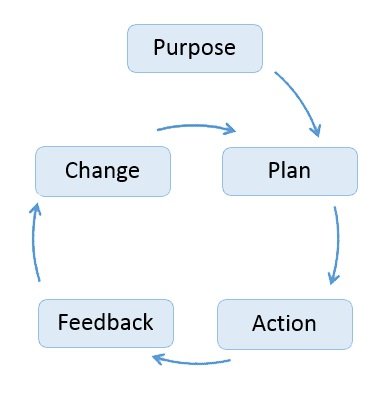Effectively Manage Change
Effectively Manage Change
Change management training is important because there have been enormous changes in the way that we shop, how we entertain ourselves, how we spend our leisure time and how we do business.
But for many, this change means a feeling of uncertainty. Most people don't like uncertainty: they say things like "Better the devil you know!"
However: it is important to remember that:
- If you want things to get better, then you must be willing to accept change.
- If you want things to get better, then you must be willing to make and implement some tough changes.
All improvement implies "making a change"
Positive Change management
Change management is an acceptance of the fact that the current situation is never static. It is in a constant state of flux.
In order to "live long and prosper", then we must equip ourselves with the ability to accept and implement change.
Maybe we should even be willing to initiate change. (What a concept!)
How does one go about creating a change-friendly attitude?
Create the right attitude by memorising and living in accordance with a simple, five-word formula:

- Purpose
- Plan
- Action
- Feedback
- Change
We call this the success formula
- State your purpose (first to survive and then, grow!)
- Formulate in writing, your best plan,
- Take decisive action, based on the plan
- Gather and evaluate the feedback, both the positive and the negative. Discover where the plan isn't working.
- Make progress by continually changing, according to the negative feedback given at point 4.
Remember that all good progress is made by continually changing: making continuous evolutionary steps towards a stated goal.
Step one of the change management success formula: Set a SMART goal
Ensure your change is not away from something: but towards something - towards a stated affirmative goal.
Set your goal as a positive, affirmative statement. For example not as: "I don't want to be fat" but rather: "I do want to be fit"
S = SPECIFIC:
Define the goal specifically: describe the goal numerically and define each term.
M = MEASURED:
Decide how you will measure the feedback. How will you know whether you are making good progress or not?
A = ACHIEVEABLE:
Name the skills you will need to acquire.
R =REALISTIC:
Identify the constraints that you will have to deal with:
- Time constraints
- Financial constraints
- Physical constraints
- Legal constraints
T = TIME DRIVEN:
Set a time deadline: What and when are the milestones?
Step two: Build the practical plan of action
When you know all of the above information, gather the team and "Map out the plan".
Use a mind mapping technique to identify the steps.
When you have finished, you should have the steps laid out in the proper time-sequenced order.
Everyone must know what is expected.
Strive to create and sustain a can-do attitude.
A can-do attitude is based upon a belief that you DO possess the collective ability and desire, sufficient to construct a future that is better than either the present or the past."
If the "Successful change formula" is so simple: then how come everyone doesn't do it?
Most people don't know about the five part success formula, and even if they do, then most people don't like:
- Part one of the success formula: Committing to goals (for fear of not achieving them)
- Part four of the success formula: Negative feedback, criticism, setbacks and defeats
- Part five of the success formula: Change (most people don't like change)
How do you go about creating a change-friendly organisation?
Create the right organisational mind-set by teaching everyone in the organisation (especially the managers) how to implement this simple, five-word formula:
- Purpose
- Plan
- Action
- Feedback
- Change
For more information about change management training visit the Corporate Coach Group website
You or your colleagues might also be interested in our newest Change Management Questionnaire
Definition: success formula
In business change work, the success formula is a process that always: 1) sets a clear purpose, 2) writes a step-by-step plan, 3) turns the plan into fast action, and 4) reads feedback to adjust and keep changing. If any part is missing, the method stops being the success formula.
Show CG4D Definition
- Starts with a clear stated purpose
- Creates a written, ordered plan
- Drives prompt action on the plan
- Uses feedback to adjust and change
Article Summary
Change feels tough, yet progress depends on it. State a clear purpose, make a plan, act fast, read feedback and adapt. Follow this five-step formula to set SMART goals and build a team that treats change as everyday progress.
Frequently Asked Questions
Here are some questions that frequently get asked about this topic during our training sessions.
Why do many people resist change at work?
What is the five-word success formula for change?
How does using SMART goals aid change management?
Why is feedback vital in the success formula?
How can a team build a change-friendly mindset?
What limits should a realistic change plan note?
How often must we review and adjust the plan?
Thought of something that's not been answered?
Did You Know: Key Statistics
Gartner’s 2023 Change Management Benchmark found only 34% of company change projects meet their goals, while 50% fall short and 16% show mixed results. LinkedIn Learning’s 2024 Workplace Learning Report shows 75% of learning leaders plan to grow spending on change-management skills this year.Blogs by Email
Do you want to receive an email whenever we post a new blog? The blogs contain article 5-10 minutes long - ideal for reading during your coffee break!
Further Reading in Change Management
-
Technology Accelerates Change
Technology change is reshaping work and life. Learn three rules to embrace rapid shifts, learn from young talent and keep core values with change management.
Read Article > -
What is Change Management?
Learn the definition of change management, key models, the five-part success cycle and how training turns change into lasting improvement in your organisation.
Read Article > -
Why do people hate change?
Understand why people resist change, how habits and uncertainty fuel fear, and learn steps to break resistance with clear goals and change management training.
Read Article > -
What are the Principles of Change Management?
Learn eight change management principles that give teams clear purpose, smart plans, focused action and feedback loops, turning resistance into progress.
Read Article > -
Learning by Experience
Learn how learning from experience and watching others helps you break bad habits, sharpen time management, and spark continuous improvement for lasting growth.
Read Article >
Looking for Change Management Training?
If you're looking to develop your Change Management Skills, you may find this Change Management Training Course beneficial:
Open Training Course Pricing and Availability
In-House Course Available Call us on 020 3856 3037 to discuss your requirements or






